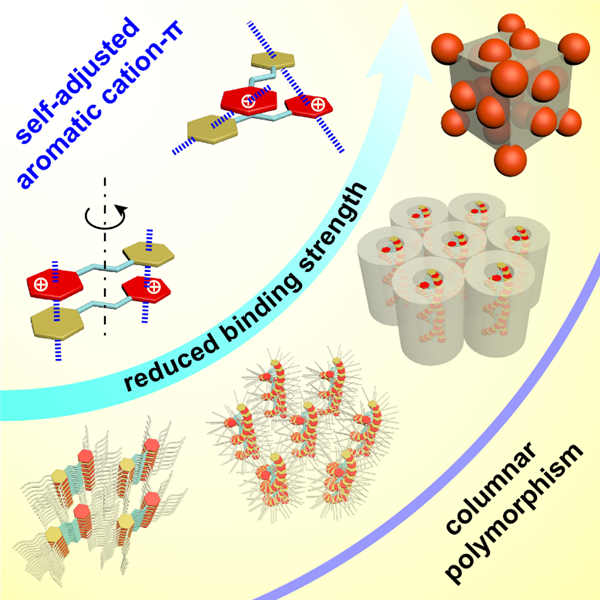Our research on the supramolecular columnar assembly induced by adaptive aromatic cation-π interactions has been published online in Chem
π-electron molecular self-assembly can obtain unique functional properties not possessed by monomers through electron coupling between molecules. In a charged π-electron system, the ordered stacking of π-electron molecules carrying the same charge can produce a new charged assembly different from the assembly of electrically neutral molecules. This charged assembly can improve the stability and conductivity of the carrier, so it has a wide range of applications in optoelectronics, ferroelectronics and catalysis. However, due to the electrostatic attraction between opposite charges, charged π-electron molecules tend to take the mode of alternating positive and negative charges stacking, thus preventing the directional migration of π-electrons in the assembly body. Therefore, it is of great scientific significance and application value to develop a method to realize the ordered packing and assembly of π-electron molecules with the same charge.
Recently, we have realized the polymorphic columnar assembly of charged π-electron molecules using adaptive aromatic cation-π interaction. A series of styrene pyridine derivatives with different alkyl tail chains were designed and synthesized. The assembly structure and molecular arrangement were studied by means of single crystal X-ray diffraction, differential scanning calorimetry, polarizing microscope and small Angle X-ray scattering. The results show that pyridine cation and benzene ring are closely bound by the aromatic ring cation-π interaction, forming a positive cylindrical assembly with alternating stacking of ends and ends. The resulting columnar assembly structure depends on the adaptive bonding pattern of the two-site cation-π interaction (from alternating to spiral stacking), and exhibits a variety of phases of alternating columnar crystals (Alt Cr), hexagonal columnar crystals (Hex Cr), hexagonal columnar liquid crystals (Hex LC), and cubic liquid crystals (Cub LC). In addition, this positively charged columnar supramolecular material can be used as an efficient intrinsic photocatalyst for CO2 photocatalytic reduction.

The results of this research were published in Chem(2024, DOI:10.1016/j.chempr.2024.01.026)。
Zhelin Zhang, a PhD student of the group, is the first author of the paper, and Associate Professor Bin Mu and Professor Wei Tian are the corresponding authors.
Link to full article :https://www.sciencedirect.com/science/article/pii/S2451929424000470。